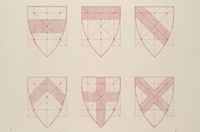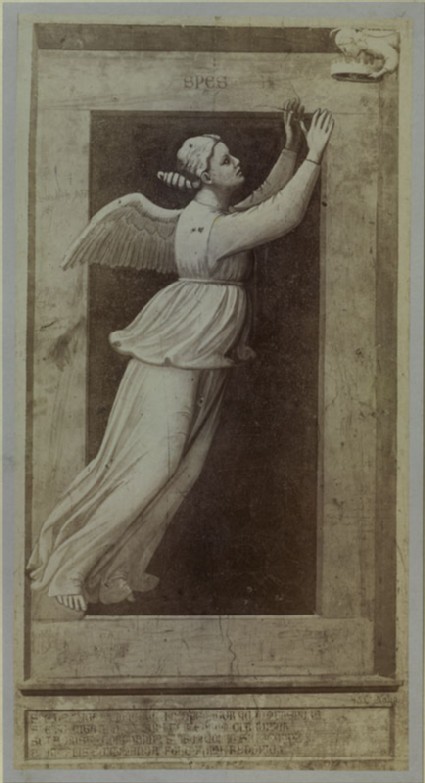Ruskin's revision to the Rudimentary series (1878)
Unpublished manuscript catalogue for proposed re-organisation of the Rudimentary series.

Ruskin's Catalogues: 1 object
Show search help- Reference URL
Actions
Photograph of Giotto's Fresco of Hope (from the series of Virtues and Vices in the Arena Chapel, Padua) Carlo Naya, firm
-
Ruskin text
R|89} Giotto’s Hope, from the Fresco at Padua. Placed at the beginning of the Italian Gothic Series in order to enforce on the student at once the fact that the power of Italian Gothic is in its use of sculpture and painting; and that no other school had so noble subordinate ministry. P. -
Details
- Artist/maker
-
Carlo Naya, firm (active 1850s - 1918) (photographer)after Giotto di Bondone (1266/67? - 1337)
- Object type
- photograph
- Material and technique
- albumen print
- Dimensions
- 270 x 141 mm (print); 277 x 150 mm (mount)
- Inscription
- Within the photograph, on the top right of the frame around the inscription at the bottom, apparently scratched into the negative and so printing black: 45.Co.Naÿa
On the back of the mount:
top centre, almost entirely trimmed away, in ink: La Spe[...]
above centre, in graphite: R, 89
below and slightly left of centre, the Ruskin School's stamp
- Provenance
-
Presented by John Ruskin to the Ruskin Drawing School (University of Oxford), 1875; transferred from the Ruskin Drawing School to the Ashmolean Museum, c.1949.
- No. of items
- 1
- Accession no.
- WA.RS.RUD.089
-
Subject terms allocated by curators:
Subjects
-
References in which this object is cited include:
References
Ruskin, John, The Ruskin Art Collection at Oxford: Catalogue of the Rudimentary Series, in the Arrangement of 1873, ed. Robert Hewison (London: Lion and Unicorn Press, 1984), cat. Rudimentary no. 89, RUD.089
Ruskin, John, Instructions in Practice of Elementary Drawing, Arranged with Reference to the First Series of Examples in the Drawings Schools of the University of Oxford (n.p., [1872]), cat. Rudimentary no. 89
Ruskin, John, Instructions in the Preliminary Exercises Arranged for the Lower Drawing-School (London: Smith, Elder, 1872), cat. Rudimentary no. 89
Ruskin, John, Instructions in the Preliminary Exercise Arranged For the Lower Drawing-School (London: Spottiswoode, 1873), cat. Rudimentary no. 89
Ruskin, John, ‘Rudimentary Series 1878’, 1878, Oxford, Oxford University Archives, cat. Rudimentary no. 89
Ruskin, John, ‘The Ruskin Art Collection at Oxford: Catalogues, Notes and Instructions’, Edward T. Cook and Alexander Wedderburn, eds, The Works of John Ruskin: Library Edition, 39 (London: George Allen, 1903-1912), 21, cat. Rudimentary no. 89
Location
-
- Western Art Print Room
Position in Ruskin’s Collection
Ruskin's Catalogues
-
Ruskin's Rudimentary series, 3rd ed. (1872)
R|89} Giotto’s Hope, from the Fresco at Padua. Placed at the beginning of the Italian Gothic Series in order to enforce on the student at once the fact that the power of Italian Gothic is in its use of sculpture and painting; and that no other school had so noble subordinate ministry. P. -
Ruskin's Rudimentary series 4th ed. (1872)
R|89} Giotto’s Hope, from the Fresco at Padua. Placed at the beginning of the Italian Gothic Series in order to enforce on the student at once the fact that the power of Italian Gothic is in its use of sculpture and painting; and that no other school had so noble subordinate ministry. P. -
Ruskin's Rudimentary series, 5th ed. (1873)
R|89} Giotto’s Hope, from the Fresco at Padua. Placed at the beginning of the Italian Gothic Series in order to enforce on the student at once the fact that the power of Italian Gothic is in its use of sculpture and painting; and that no other school had so noble subordinate ministry. P. -
Ruskin's revision to the Rudimentary series (1878)
89.This photograph begins the series illustrative of Southern Gothic; in which the student will at once recognise elements derived from the earliest Greek, and even Egyptian, schools. The Gothic form is extraneous to them, and their essential design, as here, is always in panels which are considered merely as frames for sculpture or picture. The Northern architects, who can neither paint nor carve, gradually diminished the sculpture and exaggerated the panels - until the English Perpendicular was architecture was produced, panels and nothing else.





